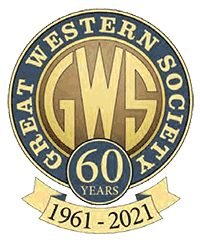Restoration of Frome North Box
Frome North Signal Cabin was purchased by the Bristol Group of the Great Western Society in 1984 and transported to Didcot Railway Centre.
With the priority to complete Radstock North Box and the diversions of the GW150 celebrations work did not start on restoring the box until 1986. Restoration of the cabin was completed by 1989, but erecting and connecting up all the period signalling equipment and linking up with Radstock North Box took another few years.
The Move to Didcot
With the restoration of Radstock signalbox nearing completion, thought was given to what the signalling project at Didcot Railway Centre was really hoping to achieve. This resulted in the production of a ‘Discussion Document’ in 1980 which essentially suggested that a second signalbox was required to allow the demonstration of passing trains between boxes. So the search for a second box was joined.

G C Drew 1983
Clearly a typical G.W. box made at Reading was required, but also one that was relatively small and in a location that was easily accessible. Then the Taunton Group requested a box of the broad-gauge period at the north of the site and B.R. announced their West of England resignalling. This suggested that one of the few remaining Mk.2 GW boxes in the area, in particular Bruton might be suitable. Bruton was suitably small, built in 1875 and had good access, however, it was of mainly brick construction and contained a hybrid frame. A reservation was placed on the box in early 1983, in the expectation that it would become available around October 1984.
The G.W.R. stud-locking frame of 25 levers in Bruton was unusual in having 4" between the lever centres instead of the usual 5 ¼" centre. Unfortunately this spacing would preclude our providing a label board - a long brass strip set behind the levers which described their function - as with a 4" centre frame you would not be able to read the board between the gaps. So the first stage in the downfall of Bruton came with the decision not to buy the frame and instead to obtain the 5 ¼" centre stud frame from Stoneycombe Sidings during June 1984. The second stage came when BR informed us that Bruton was closing on December 7th 1983 giving only three weeks notice.
(BGN Jul 84; GWS NN 148a)
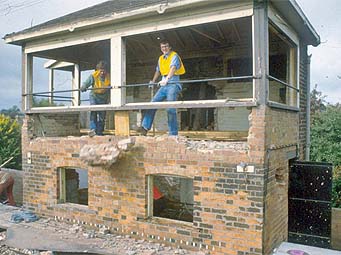
Therefore it was decided to change to our fall back option - Frome North which was a similar building and would be available in October 1984 when the job could be undertaken with proper planning.
The lift was planned for October 28th 1984 three weeks after the box closed at 08.00 on Saturday October 6th. In the intervening four weekends the box was prepared for movement by demolition of the bulk of the brick base and the erection of a huge timber girdle around the wooden top, which was actually only ¾ of a box when the brick back is removed. Other issues included closure of a main road for 3 hours, and isolating nearby overhead electricity cables. Sparrows Crane Hire offered a complete package deal including movement and off-loading at Didcot.
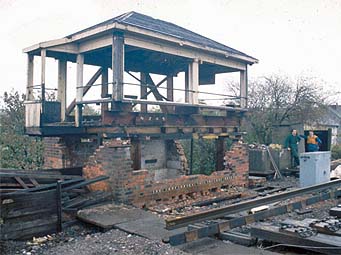
After the closure of the box by BR on the 6th the girdle was erected, having been pre-fabricated out of huge baulks from the post-office demolition in Bath. The roof was stripped to save weight and it was creosoted to provide temporary protection from the elements.
Sunday October 28th 1984 began at 6.00 a.m. with the collection of all the concrete blocks purchased from the area and loading them onto a 3-ton lorry that was being used to bring all the ‘extras’ up to Didcot.
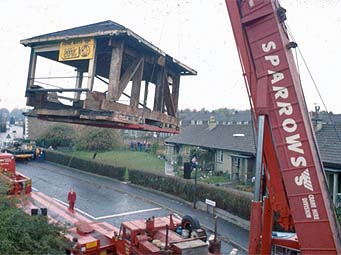
The crane arrived at 9 a.m. and the lift began in front of a huge crowd of local people. With the stretchers in place the lift proved no problem and the box was very soon on the lorry and on its way to Didcot.
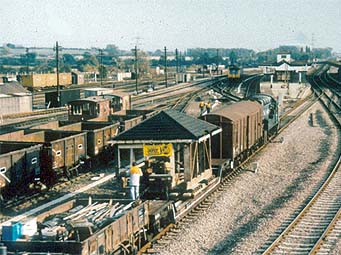
On the morning of Monday 29th confusion reigned supreme in the provender yard. We had rail wagon, signalbox, workers and loading inspector but no crane. After a three hour wait it finally turned-up - just after we had adjourned to the station for tea and the loading went very smoothly though not quite quickly enough to prevent the shunters going for lunch and another 1½ hour wait. Finally at about 2.30 the journey onto Didcot site began via some very unusual goods lines at about 5 m.p.h.
The description of the move above, is an adapted and much shortened version of an article: ‘The Frome North Project’ by Alan Price. Great Western Echo — No. 89. Spring 1985 pp, 4-6
Restoration
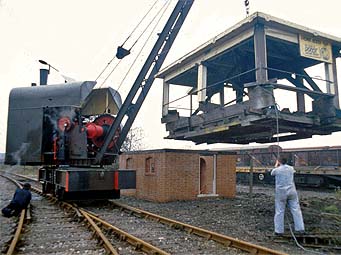
Once the box top had been recovered and safely stored on site, proceedings were somewhat interrupted by the commissioning of the level crossing and Radstock North box, together with the other events of GW150 in 1985.
However the concrete 'raft' foundations of the box were completed by June 1986 and the brick locking room was complete by September of that year.
It was not until November 1987 that all was ready for the remains of the box top to be lifted onto the new brick base.
Fortunately as the box top was lighter than that of Radstock, particularly in view of the removal of the slates and windows from the box, it was possible to use the site 5t steam crane to undertake the lift.
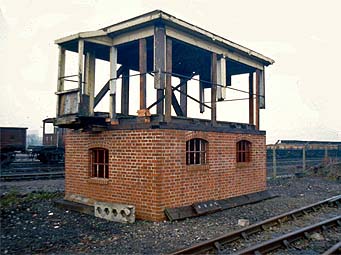
Once on top of the brick base, the next stage was to complete the remaining brickwork - mainly the rear wall. It was then possible to reinstate a replica of the original vertical boarding under the windows, together with replacement window sills and repair to rotten timber when necessary.
The final parts of the exterior restoration involved the installation of new window frames and box steps to the original pattern, and re-slating the roof with new materials.
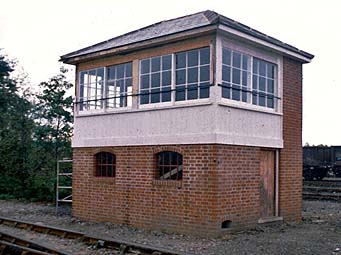
Once this was complete the box was fully repainted in traditional Great Western light and dark stone and attentions could turn to interior fittings and the creation of the broad-gauge period signalling installation which was to surround the box.

A R Hook 6-Aug-1989
At this stage the box looks somewhat isolated, there is no point-rodding or signal wires, nor any sign of habitation. To achieve the full effect the next few years were spent not only building a complete 1870s period signalling installation, but also, putting up such items as a telegraph pole route and appropriate staff exchange apparatus.
As well as this a considerable amount of landscaping was carried out, involving cutting trees back, planting and trimming hedges, planting a flower border and a rose bed and surfacing the area with boards, paving and ash as appropriate, not to mention growing some strips of grass on either side of the box.
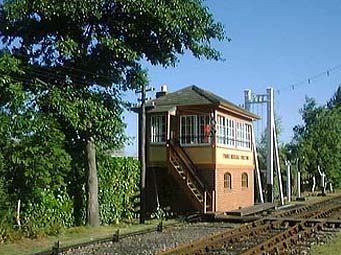
The finished result is, we think, a box in harmony with its surroundings. As with all our work at Didcot, we aim to make the buildings look as though they have 'always' been there and now that the box has been in place for several years, that is what we believe we have achieved with Frome Mineral Junction Signal Cabin.
